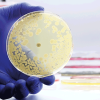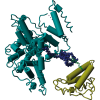This month: Thiomargarita magnifica

What is Thiomargarita magnifica?
It is officially the world’s biggest bacterium after being discovered living on sunken, decaying mangrove tree leaves in the French Caribbean.
How big is it?
It can be as big as 1 cm in length, which is pretty big compared with the average bacterium, which is 0.002 mm long.
What does it look like?
It is visible without a microscope and is a similar size and shape to a human eyelash.
Tell me more.
To put its size in context, Jean-Marie Volland from the Joint Genome Institute at the Lawrence Berkeley National Laboratory said: “These bacteria are about 5000 times larger than most bacteria. It is the equivalent for us humans to encounter another human who would be as tall as Mount Everest.”
Should we be worried about this?
Nope, no need worry – it is not dangerous and can’t cause disease in humans.
How did this discovery come about?
It was actually first identified back in 2009 in Guadeloupe, but Dr Volland and colleagues have only recently started studying it in detail.
Where can I read more?
You can read their new paper, “A centimeter-long bacterium with DNA contained in metabolically active, membrane-bound organelles”, here – bit.ly/3ypRcel.
Image credit | Shutterstock




